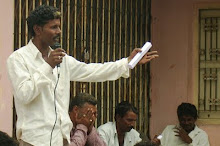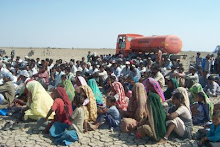Land Conflict Watch: National: Wednesday, 24 Jan 2024.
Land Conflict Summary
Agariyas of the Santalpur block of Gujarat's Patan district have alleged discrimination by the Forest Department officials in granting permits to enter the Little Rann of Kutch (LRK) for salt farming.
In September 2023, the state government allowed salt pan workers with leases up to 10 acres to continue their traditional salt production in LRK. Since then, several Agariyas from Dhandhdhra, Halwad, and Patadi were given permission to enter the LRK, but none of the 1,200 salt farmers from the Santalpur side of Patan district were allowed to enter the area.
Agariyas, the traditional salt farmers, have been harvesting salt in the Little Rann of Kutch for decades. The typical salt farming season starts around Dushera in October, but even after two months, the salt farmers were still waiting for the permission. "The Forest Department told us that they need some time to verify and finalize the list ... thus we were waiting. We do not have any other source of livelihood and today sit ideal at home," Narubhai Koli, who has been farming salt for six generations, from the Santalpur Rann was quoted as saying.
The Principal Chief Conservator of Forests (PCCF) (Wildlife) Nityanand Srivastava said, “We are allowing only those whose name are there in the settlement report”, though underlining, only those “eligible for one well” will be permitted to do salt farming. However, salt farmers claim their names are mentioned in the government survey and settlement records.
Bharat Singh Dabhi, Lok Sabha Member from Patan, also wrote a letter to the Chief Minister of Gujarat highlighting the fact that Agariyas from his constituency have been denied entry into the LRK despite them being officially listed in government survey and settlement records. He added that the discrepancy in allowing salt farmers from one side while denying access to those from another side within the same LRK raises questions about the Forest Department's operations.
Meanwhile, the Gujarat High Court on January 18, 2024 directed the Principal Chief Conservator of Forests to submit a reply by 29 January in response to a petition filed by members of Agariya community. The court emphasised that Agariyas who possess identity cards, should be permitted to engage in salt farming, as it constitutes their livelihood. The Court found no valid reason, based on the available records, to deny them access to the desert.
The Survey and Settlement Report was prepared to seek a grant from the World Bank to conserve biodiversity of the LRK’s Wild Ass Sanctuary. The report, initiated in September 1997 and completed in 2016, left out a large number of Agariyas from the list, prompting their demand for inclusion. Reportedly, only 189 Agariyas were included in the list for Santalpur block, as against estimates of up to 1,200.
After the settlement report was released, representatives of aggrieved Agariyas submitted a memorandum to the chief minister, attaching historic documents dating back to the British era and showcasing the community's involvement in salt cultivation. Following which, on 4 September 2023, the state government decided to allow all traditional Agariyas to continue salt harvesting upon simple registration, the verification of which would be done during on-site survey. It was also decided that the survey and settlement process list would be revised by doing on-site survey so that seasonal user rights were recognised on a permanent basis.
In 1973, approximately 4000 square kilometers of LRK was designated as a Wild Ass Sanctuary (WAS), protecting the Indian wild ass, exclusively found in the Kutch region of Gujarat. However, the presence of Agariyas was viewed as a threat to wildlife protection efforts, leading to eviction notices, restricted access to welfare schemes, and a lack of livelihood insurance during natural disasters.
Agariyas, however, claim that there is no conflict between them and wild ass, as census data shows a significant increase in the wild ass population from 700 in 1973 to 6,082 in 2019.
Land Conflict Summary
Agariyas of the Santalpur block of Gujarat's Patan district have alleged discrimination by the Forest Department officials in granting permits to enter the Little Rann of Kutch (LRK) for salt farming.
In September 2023, the state government allowed salt pan workers with leases up to 10 acres to continue their traditional salt production in LRK. Since then, several Agariyas from Dhandhdhra, Halwad, and Patadi were given permission to enter the LRK, but none of the 1,200 salt farmers from the Santalpur side of Patan district were allowed to enter the area.
Agariyas, the traditional salt farmers, have been harvesting salt in the Little Rann of Kutch for decades. The typical salt farming season starts around Dushera in October, but even after two months, the salt farmers were still waiting for the permission. "The Forest Department told us that they need some time to verify and finalize the list ... thus we were waiting. We do not have any other source of livelihood and today sit ideal at home," Narubhai Koli, who has been farming salt for six generations, from the Santalpur Rann was quoted as saying.
The Principal Chief Conservator of Forests (PCCF) (Wildlife) Nityanand Srivastava said, “We are allowing only those whose name are there in the settlement report”, though underlining, only those “eligible for one well” will be permitted to do salt farming. However, salt farmers claim their names are mentioned in the government survey and settlement records.
Bharat Singh Dabhi, Lok Sabha Member from Patan, also wrote a letter to the Chief Minister of Gujarat highlighting the fact that Agariyas from his constituency have been denied entry into the LRK despite them being officially listed in government survey and settlement records. He added that the discrepancy in allowing salt farmers from one side while denying access to those from another side within the same LRK raises questions about the Forest Department's operations.
Meanwhile, the Gujarat High Court on January 18, 2024 directed the Principal Chief Conservator of Forests to submit a reply by 29 January in response to a petition filed by members of Agariya community. The court emphasised that Agariyas who possess identity cards, should be permitted to engage in salt farming, as it constitutes their livelihood. The Court found no valid reason, based on the available records, to deny them access to the desert.
The Survey and Settlement Report was prepared to seek a grant from the World Bank to conserve biodiversity of the LRK’s Wild Ass Sanctuary. The report, initiated in September 1997 and completed in 2016, left out a large number of Agariyas from the list, prompting their demand for inclusion. Reportedly, only 189 Agariyas were included in the list for Santalpur block, as against estimates of up to 1,200.
After the settlement report was released, representatives of aggrieved Agariyas submitted a memorandum to the chief minister, attaching historic documents dating back to the British era and showcasing the community's involvement in salt cultivation. Following which, on 4 September 2023, the state government decided to allow all traditional Agariyas to continue salt harvesting upon simple registration, the verification of which would be done during on-site survey. It was also decided that the survey and settlement process list would be revised by doing on-site survey so that seasonal user rights were recognised on a permanent basis.
In 1973, approximately 4000 square kilometers of LRK was designated as a Wild Ass Sanctuary (WAS), protecting the Indian wild ass, exclusively found in the Kutch region of Gujarat. However, the presence of Agariyas was viewed as a threat to wildlife protection efforts, leading to eviction notices, restricted access to welfare schemes, and a lack of livelihood insurance during natural disasters.
Agariyas, however, claim that there is no conflict between them and wild ass, as census data shows a significant increase in the wild ass population from 700 in 1973 to 6,082 in 2019.
















.jpg)
.jpg)
.jpg)
.jpg)













No comments:
Post a Comment